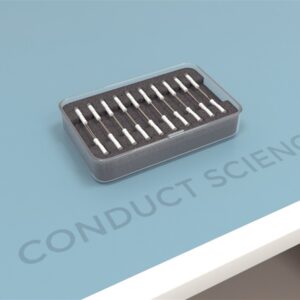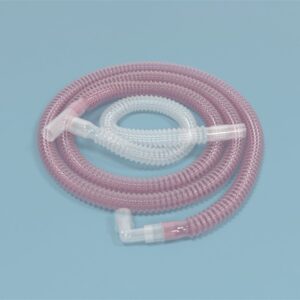$1,490.00

MazeEngineers empowers preclinical neuroscience research with meticulously designed, customizable behavioral apparatuses. From manual classic mazes to fully automated smart systems, we provide the tools scientists need to capture high-quality, reproducible data for studies on learning, memory, anxiety, and depression.



Features |
1.5 L trapezoidal tank |
Height: 15 cm; width: 7 cm |
Base tank length:23 cm; the mouth of the tank length: 28 cm |
Mirror: 15 x 7 cm |

The Mirror Biting test is utilized to assess various social behavior phenotypes in fish species. It finds applications in studying neuropsychiatric and neuropsychological disorders like schizophrenia, personality disorders, and autism, which often manifest social deficits. This test employs mirror image simulation to quantify behaviors such as boldness, aggression, and sociability, offering better control over behavioral variability and standardization for repeated trials with the same subjects.
Among fish species, the zebrafish model is particularly favored for mirror tests due to its genetic similarity to humans and highly social nature. Zebrafish exhibit robust social behaviors including shoaling, boldness, aggression, and social preferences, making them well-suited for investigating social interactions. In mirror tests, zebrafish often display bold behaviors by biting the mirrored surface or actively interacting with their reflection through rapid movements. These behavioral responses provide valuable insights into social interactions and behaviors.
Pham’s mirror biting apparatus features a trapezoidal tank with a mirror securely fitted inside. The Mirror Biting task can involve placing the mirror in the tank beforehand or introducing it mid-trial to introduce novelty. This setup serves as a versatile tool in biobehavioral research, capable of evaluating anxiety through tests like the Novel Tank Diving test. Other variations of mirror-based tests include Mirror Biting (Cattelan), Mirror Biting (Balzarini), and Mirror Biting (Elwood).
The Mirror Bite setup comprises a trapezoidal tank with a capacity of 1.5 liters, featuring dimensions of 15 cm in height and 7 cm in width. The tank’s base measures 23 cm in length, expanding to 28 cm at its mouth. A mirror measuring 15 x 7 cm is integrated into the apparatus. For enhanced data recording and observational purposes, the tank is typically partitioned into distinct approach zones.
Before commencing experiments, ensure meticulous cleaning of the apparatus. Fill the tank with fresh, clean water for each trial. Change both the stimulus shoal and the water in the experimental tank once every three trials to maintain consistency and minimize potential variables. Properly illuminate the tank using overhead lighting to ensure clear visibility. For tracking and recording behavioral data, utilize video software such as Noldus Ethovision XT. Maintain the water temperature at ambient levels throughout the experiments.
Pretraining: Place groups of fishes from the same holding tank into a pretreatment beaker for at least 5 to 20 minutes. During this period, drugs to investigated can be mixed in with the water of the pretreatment tank before introducing the fishes.
Place the group into the novel tank (without the mirror) and allow them about 3 minutes to acclimate to the environment. Observe the social interactions between the fishes for at least 3 minutes.
The Mirror Biting test can be conducted using two protocol that both provide an effective way of evaluating the social behaviors.
Allow the subject to acclimate in the tank undisturbed for a minimum of 18 hours. Introduce the mirror into the tank with careful consideration to minimize disruptions to the environment and the fish. Monitor and record the interactions between the fish and the mirror for a duration of at least 5 minutes.
This experimental procedure typically elicits heightened territorial behaviors in the fish, influenced by the novelty and presence of the mirror.
Position the mirror on the inner side of the tank and partition the tank into designated zones: a contact area (0.5 cm from the mirror) and an approach area (3 cm from the mirror). Introduce the fish into the tank and promptly initiate observation of their social behaviors.
This experimental approach leverages the novel stimuli provided by both the mirror and the tank setup to facilitate the observation of social behaviors. However, it is important to note that this protocol may not be appropriate for fish displaying anxious tendencies.
In this study, experimentally naïve zebrafish were utilized to investigate the impact of acute ibogaine exposure on social interactions stimulated by mirrors. Subjects were initially exposed to either drug-treated solutions (10 and 20 mg/L of ibogaine) or a drug-free vehicle solution for 20 minutes in 1-liter beakers. Following this pre-exposure period, the subjects underwent two tests in separate trials.
Firstly, in the novel tank test without a mirror, subjects were assessed for anxiety-related behaviors and locomotion over a 6-minute period. Results indicated that at 20 mg/L ibogaine reduced freezing duration, while at 10 mg/L it increased freezing frequency. Both doses significantly reduced the latency to enter the top half of the tank compared to controls.
Secondly, in the mirror test conducted within the same tank setup but with a mirror fixed inside, subjects’ aggressive behaviors were evaluated over another 6-minute trial. The findings revealed significant effects of the drug on various parameters, including total distance traveled, average velocity, bottom contacts, total approaches, and total mirror contacts.
This research provides insights into the behavioral effects of ibogaine on zebrafish social interactions under mirror stimulation conditions (Cachat et al., 2013).
In a study involving African cichlid fish (Astatotilapia), researchers investigated differences in behavioral, hormonal, and brain activity when the fish interacted with either a real opponent or a mirror image. Dominant males were categorized into three groups: those encountering a mirror, a real opponent, or an empty tank (control group). The experiment involved initially introducing fish into the tank with a divider, which was subsequently removed to reveal one of the three conditions.
Subjects were evaluated for overall aggression levels. Interestingly, no significant differences in total aggression or its associated components were observed between encounters with real opponents versus mirror images. However, notable distinctions emerged in brain activity. Fish that engaged with mirror images exhibited heightened egr-1 expression in the dorsolateral telencephalon, whereas those interacting with real opponents showed increased c-fos expression in the hippocampus homolog. Moreover, mirror-fighting fish displayed elevated levels of egr-1 and c-fos expression in the dorsomedial telencephalon compared to their counterparts in real combat scenarios (Desjardins and Fernald, 2010).
In a study comparing social behaviors among three strains of zebrafish—TM1, Nadia, and SH—the differences were explored through boldness tests. Following these initial assessments, subjects were individually isolated for a minimum of 18 hours. The mirror biting test was then conducted by introducing a mirror into each tank.
Results revealed notable differences among the strains, particularly with the TM1 strain exhibiting a significantly higher frequency of mirror biting compared to the Nadia and SH strains (Mortez et al., 2005).
The following parameters can be recorded during the Shoaling test.
The following behaviors and parameters can be observed in the Mirror Biting test.
Mirror tests are widely recognized for their reliability in assessing fish behavior within social contexts, with observed behaviors often correlating positively with shoaling tendencies. The mirror in the tank can be adjusted, either removed or added, based on experimental requirements.
Two distinct protocols are available for the Mirror Biting test, providing flexibility in introducing varying levels of novelty. Introducing the mirror to a tank already housing fish tends to elicit more pronounced territorial behaviors.
The apparatus is straightforward to assemble and can be easily customized to accommodate specific research needs. The tank’s narrow design facilitates the creation of varied shoal densities, enabling precise evaluation of shoaling behaviors.
Although a correlation exists, the mirror test is still a crude method for understanding sociability as some mirror-directed behavior could be the result of fear avoidance. Further, the mirror test does not emulate the characteristics of a real stimulus conspecific thus requiring caution when interpretations are made. The subject may also not be able to see the mirror image from close proximity clearly. The test also deprives the subject of chemical cues involved in typical social interactions between fish when the subject is tested using the mirror image stimulus. Subject’s and the stimulus conspecific’s social personality type also greatly influences the results. Anxious fishes may not perform as expected when introduced to the tank already housing the mirror.
Cachat J, Kyzar EJ, Collins C, Gaikwad S, Green J, Roth A, El-Ounsi M, Davis A, Pham M, Landsman S, Stewart AM, Kalueff AV (2013). Unique and potent effects of acute ibogaine on zebrafish: the developing utility of novel aquatic models for hallucinogenic drug research. Behav Brain Res. 236(1):258-69. doi: 10.1016/j.bbr.2012.08.041.
Desjardins JK, Fernald RD (2010) What do fish make of mirror images? Biology Letter 6(6): 744–747
Marks C, West TN, Bagatto B and Moore FBG (2005). Developmental environment alters conditional aggression in zebrafish. Copeia 4:901–908
Moretz AA, Martins EP, Robinson BD (2007). Behavioral syndromes and the evolution of correlated behavior in zebrafish. Behav Ecol 3:556–562
Oliveira RF, Silva JF, Simoes JM (2011) Fighting zebrafish: characterization of aggressive behavior and winner-loser effects. Zebrafish 8(2):73–81
Pham M. et al. (2012) Assessing Social Behavior Phenotypes in Adult Zebrafish: Shoaling, Social Preference, and Mirror Biting Tests. In: Kalueff A., Stewart A. (eds) Zebrafish Protocols for Neurobehavioral Research. Neuromethods, vol 66. Humana Press, Totowa, NJ
There are no questions yet. Be the first to ask a question about this product.